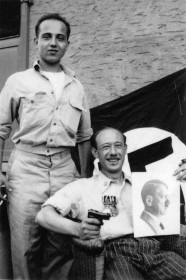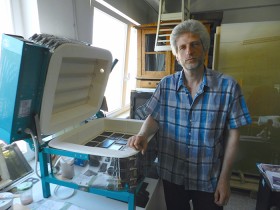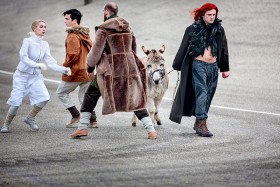Program Director Cilly Kugelmann on the Exhibition “NO COMPROMISES! The Art of Boris Lurie”

“As this image of Lurie with his brother-in-law Dino Russi from 1946 shows, the NO!art artists, in reclaiming the swastika symbol, robbed it of its symbolic value.” (Cilly Kugelmann)
Boris Lurie Art Foundation, New York
Our major retrospective dedicated to Boris Lurie opens 26 February 2016 (for more information see www.jmberlin.de/lurie/en). Blog editor Mirjam Bitter spoke with Cilly Kugelmann about the artist, his provocative work, and the possible impact today of the taboos that he broke throughout his career.
Mirjam Bitter: What is your view of Boris Lurie? What sort of a guy was he? What distinguished him as an artist?
Cilly Kugelmann: The man and the artist Boris Lurie was shaped by his experience of persecution and concentration camps under the Nazi regime. And yet, unlike other artists who faced similar experiences, I feel he cannot be described as a “Holocaust artist.” With the exception of some early drawings from 1946 and a few paintings from the late 1940s, he neither chronicled these events nor sought to interpret the Holocaust artistically in his work.
Then what role did the Holocaust play in Lurie’s work? → continue reading

Daniel Wiesenfeld at work. The freshly baked glass plates cool off in the oven, 2015
© Jewish Museum Berlin, photo: Anna Golus
The last few weeks, while people everywhere were sizzling in the summer sun, Daniel Wiesenfeld was ‘baking’ a hundred new works of art for our art vending machine. What good luck, meanwhile, that the machine is nearly sold out!
Daniel is presenting the Jewish Museum Berlin with what is already the third series of works for the vending machine, all three of which are incomparable. In April we received a hundred oil paintings with self-portraits of the artist bearing a variety of poignant grimaces, along with a hundred charcoal drawings featuring a number of different motifs. For this new series, Daniel decided on a technique that’s new not only for him but for the vending machine as well: stained glass.
I visited Daniel a few days ago in Berlin’s Tempelhof neighborhood. → continue reading
A Conversation with Rachel Heuberger on the Biblical Story of the Binding of Isaac and the Exhibition “Obedience”

Still from a film in the installation “Obedience”
© S. Boddeke & P. Greenaway, photo: Digidaan
The exhibition “Obedience. An Installation in 15 Rooms by Saskia Boddeke & Peter Greenaway” has been open for some time now at the Jewish Museum Berlin. As with every exhibition, this one meets the approval of our visitors to various degrees. Unlike other exhibitions however, the feedback – which often reaches us later – is different than what we might have anticipated. Indeed, this was the case with Dr. Rachel Heuberger, the curator of the Hebraica and Judaica collections at the University Library of Frankfurt. We spoke right after her visit about her thoughts and impressions.
Mirjam Wenzel: You just saw the exhibition “Obedience” by Saskia Boddeke and Peter Greenaway. How would you describe it? → continue reading


